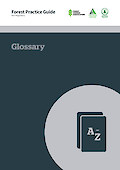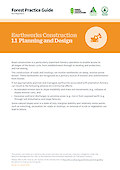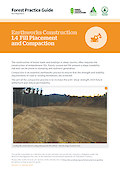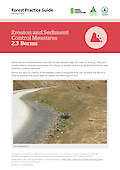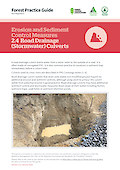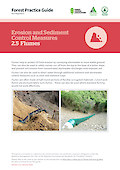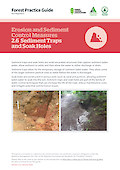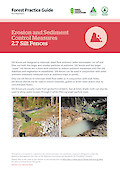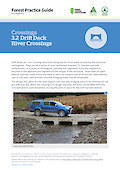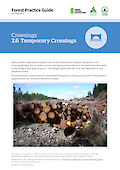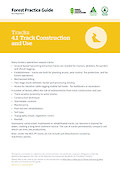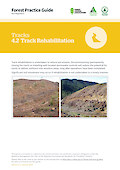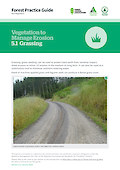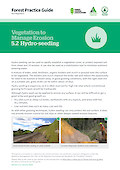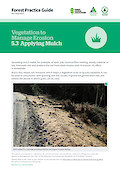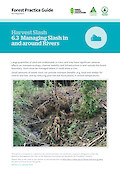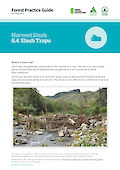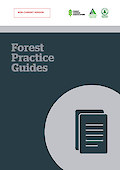Purpose
The Forest Practice Guides were first published in 2018.
The current versions (Version 2.0 updated January 2020) are to assist forest owners/managers and contractors to meet legislative requirements of the Resource Management Act 1991 (RMA) and in particular the National Environmental Standards for Plantation Forestry (NES-PF). They do not replace or override any statutory requirement. For various forestry operations, the guides provide options and information on a range of practices and methods to manage effects of the operations on the environment.
Layout
The guides cover the following forestry operations:
- Earthworks Construction (4)
- Erosion and Sediment Control Measures (8)
- Crossings (4)
- Tracks (2)
- Vegetation to Manage Erosion (4)
- Harvest Slash (4)
Under each operation there are separate guides for the different measures that may be used to manage environmental effects. Most of the guides follow a format that outlines the following:
- A description
- Where and when to use
- Design
- Construction
- Maintenance
- Other Methods
- Technical Specifications
The terminology used provides consistency with the NES-PF. For example, the word “river” includes perennial and intermittent streams, whereas the word “water body” includes rivers, lakes and wetlands.
How to use
The NES-PF has provided a consistent regulatory approach for various forestry activities including earthworks, crossings and harvesting. A major platform of the regulation is that a forestry earthworks management plan and harvest plan (a Management Plan) is to be prepared. The specifications in schedule 3 of the NES-PF set out the details of the matters to be included in such a plan. There is a requirement to describe the management practices that will be carried out.
The guides provide various options, a tool box, of management practices. It is anticipated that in describing management practices that a Management Plan may refer to a guide or part of a guide.
The guides are not statutory documents however, care must be taken to references to a guide. If a Management Plan states that a certain guide or part of a guide is going to be followed then those provisions of that guide will form part of compliance with the NES-PF regulations. In other words, the provisions will form part of your regulatory obligation under the RMA.
It is recommended that when considering management practices that the choice of specific provisions of a guide be clearly identified in a Management Plan. This is the preferred approach rather than a general comment that a particular guide will be followed.
The guides do not have to be used but they do describe forestry best practices.
Provisions of other documents such as individual company best practice documents and or operational specifications, council technical publications, the New Zealand Forest Owners Road Engineering Manual may be used to describe the management practices that will form part of any Management Plan.
To give feedback on any of the Forest Practice Guides, email FOA.
If you would like to be notified when any of the guides are updated, please email FOA.
Earthworks Construction
1.1 Earthworks Construction – Planning and Design (2.0)
PDF (1.51 MB), 11 pages, more info...
1.3 Earthworks Construction – Bulk Earthworks (2.0)
PDF (3.46 MB), 12 pages, more info...
Crossings
3.2 Crossings – Drift Deck River Crossings (2.0)
PDF (1.05 MB), 6 pages, more info...
3.3 Crossings – Ford Crossings (2.0)
PDF (2.10 MB), 7 pages, more info...
3.4 Crossings – Single Culvert River Crossings (2.0)
PDF (2.90 MB), 10 pages, more info...
3.6 Crossings – Temporary Crossings (2.0)
PDF (2.43 MB), 7 pages, more info...
Tracks
4.1 Tracks – Track Construction and Use (2.0)
PDF (4.43 MB), 12 pages, more info...
4.2 Tracks – Track Rehabilitation (2.0)
PDF (2.54 MB), 10 pages, more info...
Vegetation to Manage Erosion
5.1 Vegetation to Manage Erosion – Grassing (2.0)
PDF (0.66 MB), 6 pages, more info...
5.4 Vegetation to Manage Erosion – Slash (2.0)
PDF (5.09 MB), 12 pages, more info...
Harvest Slash
Amalgamated Guides: Archived version June 2019
PDF (9.42 MB), 152 pages, more info...


